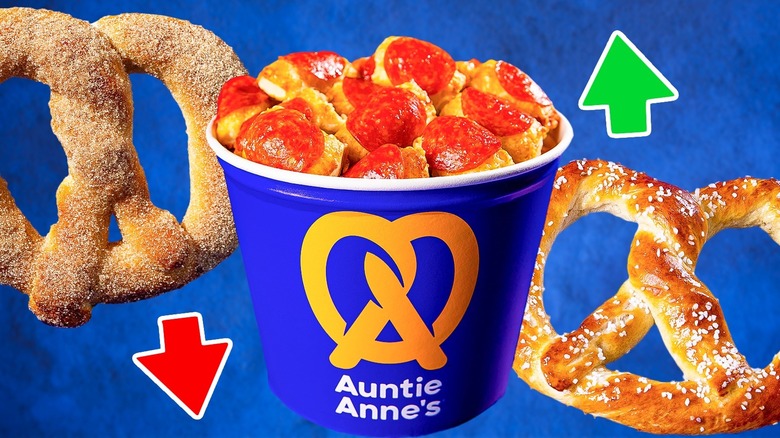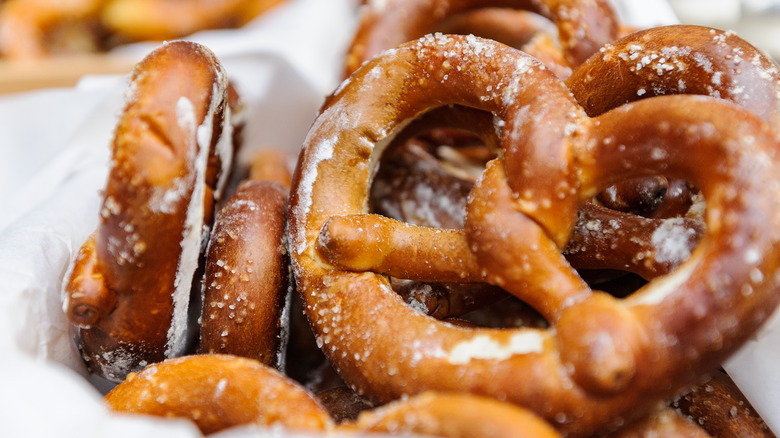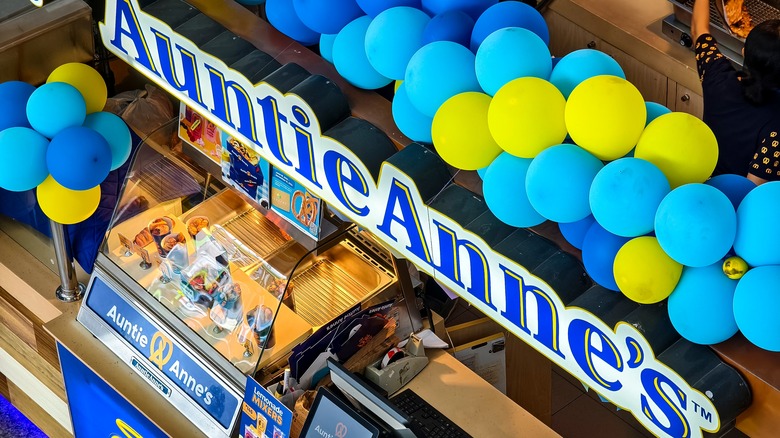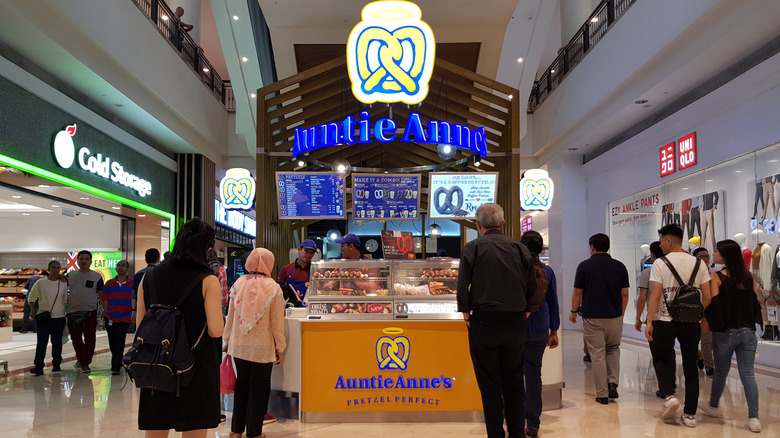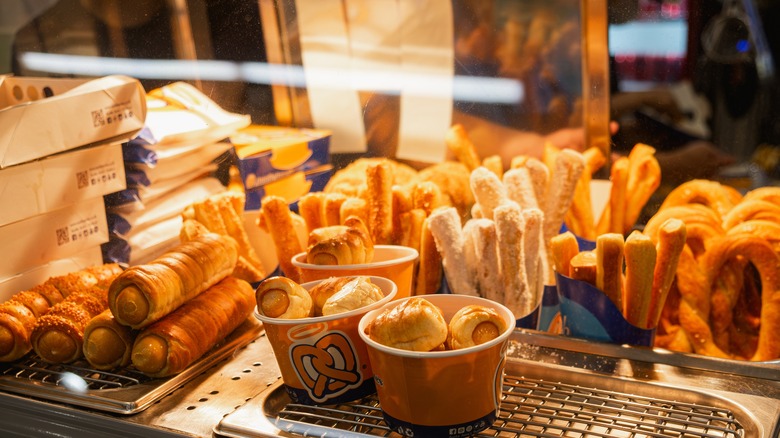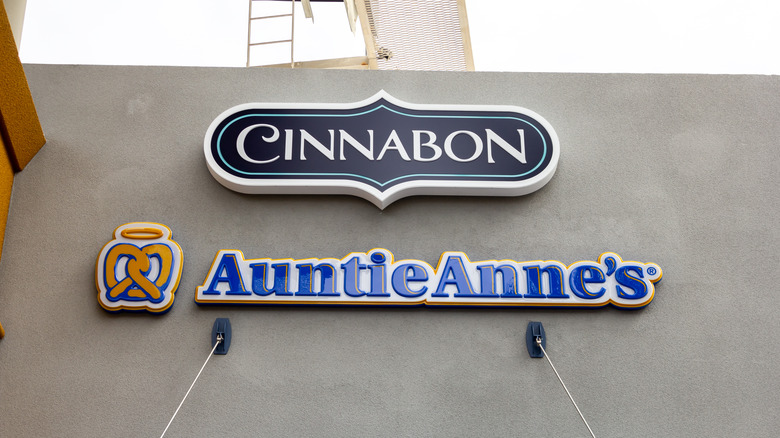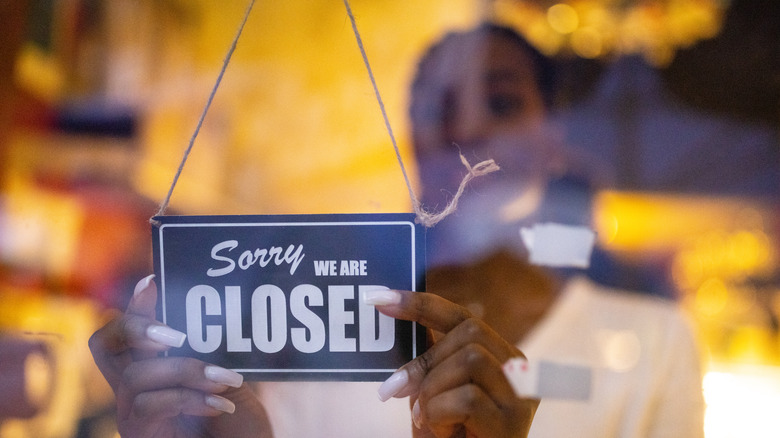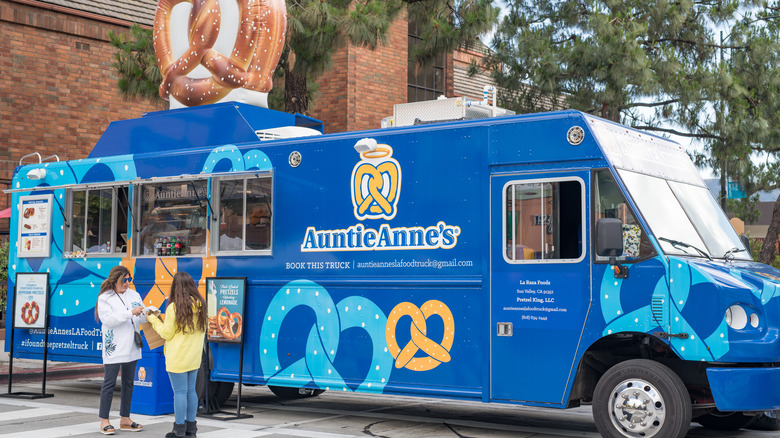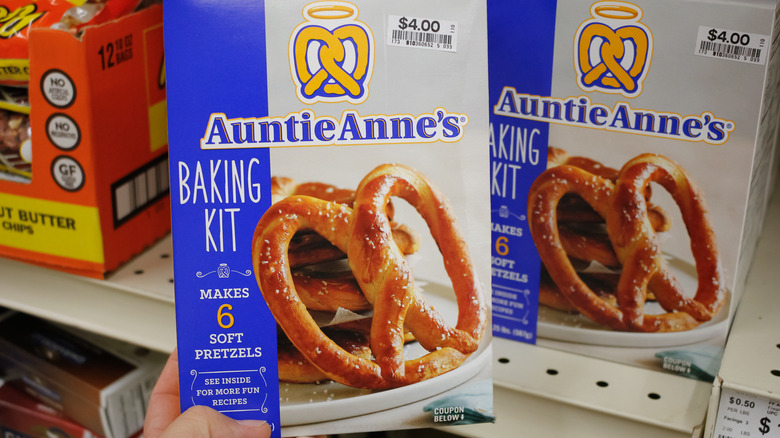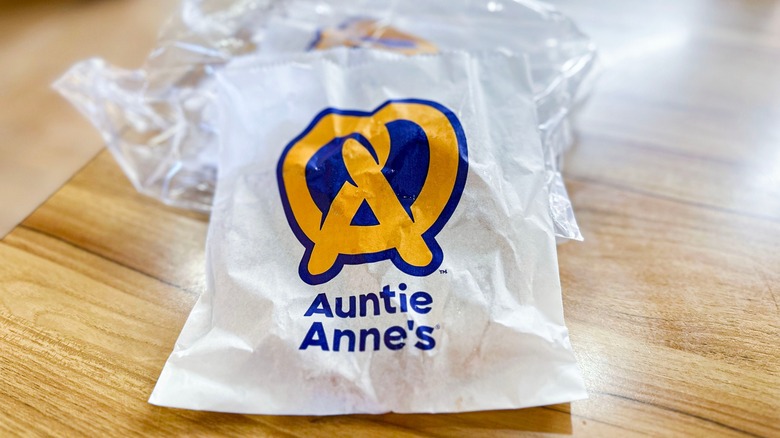The Rise & Fall And Resurgence Of Auntie Anne's
As the old saying goes, the bigger they are, the harder they fall. This has been exemplified as malls entered and then exited the American cultural zeitgeist over several decades. Many stores that were fixtures of the local mall, such as Delia's and ChiChi's, were not able to weather the storms of time. Others, such as Quiznos and Charleys Cheesesteaks, seem to be holding on by a thread as the world moves past their once-prosperous market in malls.
Auntie Anne's story is a little different than the others, as this mall classic rose to incredible heights before falling hard. But the tale of Auntie Anne's is also a story of resilience, ingenuity, and an ability to adapt. Auntie Anne's Pretzels has managed to bring itself back from the brink as malls across America closed. Today, is still a beloved part of our pop culture. Oprah is a noted fan, after all, so it must be great.
But we all know it isn't enough to have a delicious product, so what else is going on? We did a deep dive and found out how Auntie Anne's beat the odds to take its place in the world.
Who is Auntie Ann Beiler?
Auntie Anne's Pretzels was started by Anne Beiler, the real "Auntie Anne." Unlike many millionaire tycoons, Beiler did not come from money. Far from it. Beiler was born into an Amish-Mennonite community in Lancaster, Pennsylvania. Beiler began her life on a 100-acre farm living what many consider to be the stereotypical Amish life with eight children. Beiler's family eventually became what is sometimes known as "black car Amish." This meant that they decided they could use limited electricity and drive cars as long as they were an unobtrusive black color. Beiler only attended formal school until eighth grade, though she later went back and received her GED at age 50.
Beiler married at age 19 and soon after had two daughters. The family seemed perfect, but when Anne was in her 20s, tragedy struck: her 19-month-old daughter Angela was killed in a 1975 farming accident. Beiler sought support from her pastor, who took advantage of her grief and abused her during the most challenging part of her life. Under the stress, Belier's marriage to her husband Jonah began to suffer. They sought counseling, which helped. But despite her husband working as a mechanic and studying to be a counselor, by the early '80s the family was also dealing with significant financial strain. Something had to change or else the family was not going to make it — financially or otherwise.
Humble beginnings
As Beiler began to rebuild her life, find herself, and save her marriage, she also knew it was time to bring in some extra cash to support her family. Yet that was a pretty tall order even in the best of circumstances, which Beiler's certainly was not.
Beiler decided to open a simple farm stand at a local indoor market in Downingtown, Pennsylvania. The problem was that a simple stall cost $6,000 in 1988, equivalent to more than $16,000 in 2024. Beiler and her husband simply did not have that kind of cash upfront. Luckily, they were able to secure a loan from her husband's parents in order to get the small business up and off the ground.
After sprucing up the stand with some paint, Beiler opened for business. This stand did not start as "Auntie Anne's Pretzels." Instead, this was a humble stand that sold pretzels as well as ice cream and pizza. In a full circle moment, Auntie Anne's now sells pepperoni pizza bites. But at the beginning, Beiler's goal was only to make enough money to support her family. That first week, she only made $875, only a fraction of the startup cost. Beiler worried that she had made a mistake, but on the opening day, she also received flowers and an encouraging letter from her husband that helped her power through.
Standing out in a crowd
Believe it or not, there was a time when soft pretzels were not widely known outside of Pennsylvania Dutch communities. Auntie Anne's helped bring this sort of pretzels to a wider audience and built an entire industry around them. Despite that, Anne Beiler's first store didn't specialize in pretzels at all.
Beiler originally started with the recipes that had been left behind by the previous owner of her stall, though she changed them to suit her preferences. In addition, Beiler added a secret ingredient to the pretzel recipe — and yes, it is still a secret. To this day, no one knows what it is. Back in the begining, Beiler's husband suggested adding this mysterious ingredient and helped create the recipe we all know and love today.
When Belier premiered her new and improved recipe for pretzels, they were a near-instant hit. Beiler soon decided to get rid of pizza and instead focus on the increasingly popular pretzels. The profits more than doubled and suddenly, Beiler was bringing in $2,000 a weekend. The growth necessitated buying more ovens and hiring help.
Becoming Auntie Anne's Pretzels
Though business was booming for Beiler, the stand still didn't have a proper name. So, she decided to lean into her family ties and use the name given to her by her many nieces and nephews: "Auntie Anne."
With a business name and newfound success, Beiler decided it was time to expand. She opened a second stand, this time in nearby Harrisburg. Between the two locations, Beiler was making more money than she had ever imagined. That first year, Belier made about $100,000, the equivalent of about $271,000 in 2024. Not too shabby for what was supposed to be a part-time side hustle to help support her family during a tough economic time.
Business was booming at the two stores. Beiler was content, making more money than she needed, and had no intention of opening more stands. However, those around her kept insisting she should dream bigger. With her humble roots, Beiler was reluctant. But finally, in 1989, Beiler relented, allowing friends and family to franchise and open 10 stores.
Striking gold with malls
The biggest shift for Auntie Anne's came when the company decided to enter into the then-new market of mall food courts. Despite being a somewhat reluctant businesswoman, Anne Beiler clearly had a knack for growing her business. Auntie Anne's pretzels entered the mall scene in 1989.
Mall food courts at the time were a burgeoning business. A specialty restaurant that sold just a single product seemed to be a risk, but one that Beiler knew she and her franchisees could do well. Beiler relied on foot traffic to encourage people to see the stall and stop by, as well as free samples to further lure customers in. That, along with the tantalizing smell and the view of the pretzels being made in front of customers, was enough to bring many customers coming back for more. This allowed her to substantially grow the business.
Entering the mall market ended up being a smart move. By the mid-1990s, Beiler was able to grow her company's revenue to $3 million a year, earned multiple industry accolades, and had 279 stores.
Breaching the international market
Auntie Anne's showed no sign of slowing down. The company grew so big that leadership decided to section off the country to determine designated markets. Since Auntie Anne's started in Pennsylvania, the northeast area was covered. Beiler decided it was time to think broader and take Auntie Anne's all the way to the west coast.
After Auntie Anne's conquered the United States market, it was time to dream even bigger and expand into the international market. In 1995, Auntie Anne's opened its first overseas spot, a store in Jakarta, Indonesia that set the stage for even larger conquests.
Much as Auntie Anne's built a soft pretzel market in the U.S., entrepreneur Alice Sulaeman built one for Indonesia and then Singapore. After trying an Auntie Anne's pretzel on a trip to Las Vegas, Sulaeman was hooked. She became a franchisee and brought Auntie Anne's to Indonesia and then Singapore. Over the years, Sulaeman and her family have created a network of successful Auntie Anne's in the region. Sulaeman eventually passed the franchise down to her children, keeping the Indonesian and Singapore locations something of a family business, just as Beiler had done when she expanded the original American franchises.
Anne Beiler sells Auntie Anne's
After 17 years of unprecedented success, in 2005 Anne Beiler sold Auntie Anne's pretzels to her second cousin, Sam Beiler, who had been with the company since the beginning. Anne Beiler had grown Auntie Anne's to heights that she had never originally dreamed of, but found that expanding the company was hard work. Indeed, it was eating into the time Beiler could otherwise have spent with her family. Remember that Beiler founded Auntie Anne's as a way to support her family and keep them together. For the same reason, Beiler decided to sell.
While Beiler felt confident in her decision, that didn't make the process any easier. Beiler noted that while she cried over the decision for weeks, ultimately she knew that it was the right one for both her family and the company they had built.
The company remained in the family for a few more years until Sam Beiler decided to sell. At that point, he had spent over 20 years with Auntie Anne's. Beiler stated he wanted to pursue his personal passions. In doing so, the company was purchased by FOCUS brands, becoming a part of a larger portfolio including another mall superstar: Cinnabon.
Malls begin to struggle
The shift from a family-owned company to one owned by a corporation was a big one for Auntie Anne's. But there was an even larger changing happening in the wider world that would come to affect the company. Malls, which were the major stepping stone for Auntie Anne's Pretzels and provided a market that allowed the pretzel empire to grow, began to struggle and close.
Malls have been a part of American culture since the 1950s. In the first decade of their existence, over 4,500 new shopping malls opened. This proved that Americans, many of whom began living in sprawling suburbs, craved a place where they could gather and shop. Early malls didn't offer food courts the way we think of them today. However, as popularity grew, mall owners needed to find a way to keep people at malls for longer periods of time. So, by the 1970s, many began to introduce food courts. Through the 1980s and 1990s, malls became a popular spot for teens, who joined the crowds hanging out at the shops and bustling food courts. But all good things must come to an end.
Americans began to prefer shopping at all-in-one stores such as Target or Walmart. Then came the internet. As it became easier to shop from the comfort of one's home, fewer people went to the mall. With dwindling crowds and shrinking profits, many malls began to close.
The COVID-19 pandemic spells disaster
As the 2010s hit, it became clear that malls were no longer the hot market they once were. Across the U.S., malls of all sizes began to close down, leaving Auntie Anne's in a tough spot. The company's base market had been these shopping plazas and now its leaders clearly to find something else. Then a worldwide disaster struck one more major blow to the company.
In 2020, the COVID-19 pandemic ravaged what was left of the in-person industry. One Auntie Anne's franchisee noted that COVID-19 had exacerbated underlying issues with poor mall attendance. They noted that employee hours had to be reduced while revenue sagged. During the peak of the pandemic, many locations shut down entirely due to no income whatsoever. What's more, during 2020 the owners of Auntie Anne's, FOCUS, laid off more than 100 employees, citing the pandemic and a significant downturn in sales as a driving issue. Auntie Anne's was already facing a difficult time, but this could have been the final nail in the coffin.
Finding a new market outside of the mall
Though COVID-19 had dealt a serious blow to the company, Auntie Anne's wasn't done just yet. However, finding a new market for such a niche product as soft pretzels took some work. It is one thing to buy a pretzel from a stand or walk around a mall, but it is another thing entirely to go out of your way and drive somewhere just for a pretzel. The good news for Auntie Anne's is that the company is nothing if not resourceful, and has likewise gained a lot of goodwill over the years. As a result, its leaders began to experiment with other store options.
In 2021 Auntie Anne's opened its first-ever drive-thru location. This strategy still played on the Auntie Anne's reputation as a place to grab a quick snack, but potentially expanded its reach through the convenience of a drive-thru.
Additionally, that first drive-thru Auntie Anne's wasn't just freestanding but was instead combined with a Jamba Juice. The advantage of this is that, much like a mall food court, Auntie Anne's could act as a supporting treat without requiring the money and resources to support its own freestanding building. Auntie Anne's has always succeeded when in a combined space, and this was hardly any different.
Auntie Anne's staged its comeback
Adding a drive-thru location wasn't the only big change to Auntie Anne's in recent years. The company has since worked hard to bring itself back from the brink of disaster. During the COVID-19 pandemic Auntie Anne's started offering make-your-own pretzel kits. This was a smart way to engage customers who love pretzels and were at the time desperate for an activity to do with their children while everyone was cooped up under stay-at-home orders. Auntie Anne's wasn't about to stop there, however. It began to overhaul its digital presence, offering online ordering and revamping its point of sale system to enter the digital age. This change ultimately made information tracking easier and allowed the company to more easily see what changes had worked and what didn't.
The company also entered into the food truck game, offering a new option for franchisees that, once again, relied on low overhead and bypassed the need for a single freestanding location. With the addition of food trucks, Auntie Anne's could once again be at the places where large groups of hungry people gathered. While that was at one time the mall, now it could be a festival or catering for events.
Finally, the company revamped its menu, offering more bite-sized pretzel options than traditional full pretzels. These smaller versions of the classic treats are currently outselling the original larger pretzels.
Where Auntie Anne's is today
All these revamps really worked in Auntie Anne's favor, as the company now appears to be going strong. After adding drive-thrus and expanding offerings, Auntie Anne's saw a massive jump in sales, showing the company was capable of being more than just a mall attraction.
Auntie Anne's now makes nearly $800 million in global sales, while there are more than 2,000 Auntie Anne's locations spanning over 30 countries. Auntie Anne's proved that it can adapt and change with the times without truly forgetting its roots. It's also gotten savvier at marketing. On National Pretzel day the company often gives away free pretzels, a throwback to when the only marketing it did was through samples and subsequent word of mouth.
